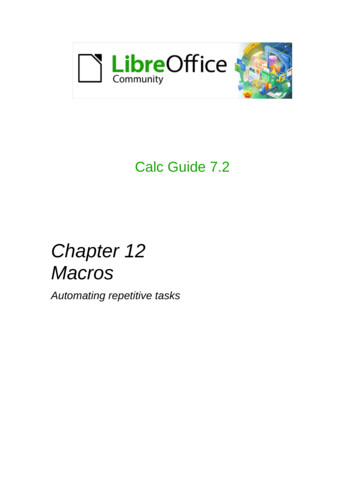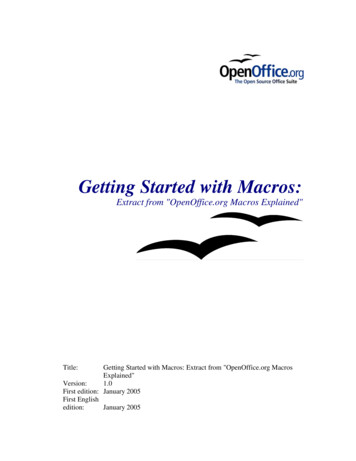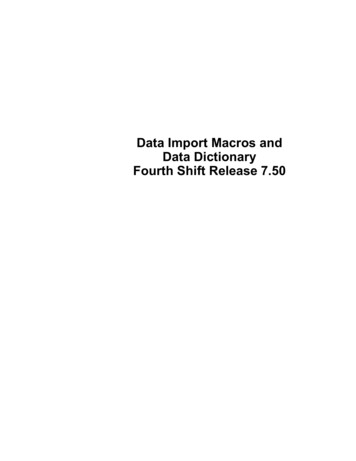
Transcription
Calc Guide 7.2Chapter 12MacrosAutomating repetitive tasks
CopyrightThis document is Copyright 2021 by the LibreOffice Documentation Team. Contributors arelisted below. You may distribute it and/or modify it under the terms of either the GNU GeneralPublic License (https://www.gnu.org/licenses/gpl.html), version 3 or later, or the CreativeCommons Attribution License (https://creativecommons.org/licenses/by/4.0/), version 4.0 or later.All trademarks within this guide belong to their legitimate owners.ContributorsTo this editionSteve FanningRafael LimaTo previous editionsAndrew PitonyakSimon BrydonFelipe ViggianoVasudev NarayananBarbara DupreySteve FanningOlivier HallotJean Hollis WeberLeo MoonsKees KriekFeedbackPlease direct any comments or suggestions about this document to the Documentation Team’smailing list: g you send to a mailing list, including your email address and any otherpersonal information that is written in the message, is publicly archived and cannotbe deleted.Published November 2021. Based on LibreOffice 7.2 Community.Other versions of LibreOffice may differ in appearance and functionality.Using LibreOffice on macOSSome keystrokes and menu items are different on macOS from those used in Windows andLinux. The table below gives some common substitutions for the instructions in this document.For a more detailed list, see the application Help and Appendix A (Keyboard Shortcuts) to thisguide.Windows or LinuxmacOS equivalentEffectTools Optionsmenu selectionLibreOffice PreferencesAccess setup optionsRight-clickControl click and/or right-clickdepending on computer setupOpen a context menuCtrl (Control) (Command)Used with other keysF11 TOpen the Styles deck in theSidebarDocumentation for LibreOffice is available at https://documentation.libreoffice.org/en/
ContentsCopyright.2Contributors. 2Feedback. 2Using LibreOffice on macOS.2Introduction.4On Visual Basic for Applications (VBA) compatibility.4Using the macro recorder.4Write your own functions.8Create a function macro. 8Using a macro as a function.12Macro security warnings. 12Loaded / unloaded libraries.13Passing arguments to a macro.15Arguments are passed as values.16Writing macros that act like built-in functions.16Deleting LibreOffice Basic macros.16Accessing cells directly.17Sorting.19Overview of BeanShell, JavaScript, and Python macros.20Introduction. 20BeanShell macros. 21JavaScript macros. 23Python macros. 25ScriptForge library.26Built-in object inspector.26Working with VBA macros.27Loading VBA code. 27Option VBASupport statement.28VBA UserForms (LibreOffice Basic Dialogs).29Conclusion.29Chapter 12 Macros 3
IntroductionChapter 13 of the Getting Started Guide (entitled Getting Started with Macros) is an introductionto the macro facilities that are available in LibreOffice. The current chapter provides furtherintroductory information about the use of macros within a Calc spreadsheet.A macro is a set of commands or keystrokes that are stored for later use. An example of a simplemacro is one that enters your address into the current cell of an open spreadsheet. You can usemacros to automate both simple and complex tasks, and they enable you to introduce newfeatures that are not built into Calc.The simplest way to create a macro is to record a series of actions through Calc’s user interface.Calc saves recorded macros using the open-source LibreOffice Basic scripting language, whichis a dialect of the well-known BASIC programming language. Such macros can be edited andenhanced after recording using the built-in LibreOffice Basic Integrated DevelopmentEnvironment (IDE).The most powerful macros in Calc are created by writing code using one of the four supportedscripting languages (LibreOffice Basic, Python, JavaScript, and BeanShell). This chapterprovides an overview of Calc’s macro facilities, mostly focused on its default macro scriptinglanguage, LibreOffice Basic. Some examples are included for the Python, JavaScript, andBeanShell scripting languages but fuller descriptions of the facilities for these languages arebeyond the scope of this document.On Visual Basic for Applications (VBA) compatibilityThe LibreOffice Basic programming language and the VBA programming language – found inmany Microsoft Office documents including Excel spreadsheets – are dialects of the BASIClanguage. If you want to use macros written in Microsoft Excel using the VBA macro code inLibreOffice, you must first edit the code in the LibreOffice Basic IDE.Some tips for converting Excel macros written in VBA are detailed at the end of this chapter.Using the macro recorderChapter 13, Getting Started With Macros, of the Getting Started Guide includes examplesshowing how to use the macro recorder and understand the generated LibreOffice Basic scripts.The following steps give a further example, specific to a Calc spreadsheet, without the moredetailed explanations of the Getting Started Guide. A macro is created and saved which performsa paste special with multiply operation across a range of spreadsheet cells.NoteUse Tools Options LibreOffice Advanced on the Menu bar and select theEnable macro recording (may be limited) option to enable the macro recorder.1) Use File New Spreadsheet on the Menu bar to create a new spreadsheet.2) Enter the numbers shown in Figure 1 into cells A1:C3 of Sheet1 in the new spreadsheet.Figure 1: Enter numbers into cellsA1:C34 Chapter 12 Macros
3) Select cell A3, which contains the number 3, and use Edit Copy on the Menu bar tocopy the value to the clipboard.4) Select all cells in the range A1:C3.5) Use Tools Macros Record Macro on the Menu bar to start the macro recorder. Calcdisplays the Record Macro dialog, which includes a Stop Recording button (Figure 2).Figure 2: Record Macro dialog with Stop Recordingbutton6) Use Edit Paste Special Paste Special on the Menu bar to open the Paste Specialdialog (Figure 3).Figure 3: Paste Special dialog7)Select the All option in the Paste area and Multiply in the Operations area (both optionsare highlighted with a red box in Figure 3), and click OK. The values in cells A1:C3 arenow multiplied by 3 (Figure 4).Figure 4: Cells A1:C3 multiplied by 3Using the macro recorder 5
8) Click the Stop Recording button to stop the macro recorder. Calc displays a variant ofthe Basic Macros dialog (Figure 5).NoteThe Save Macro In area of the Basic Macros dialog shows the existing LibreOfficeBasic macros, hierarchically structured into library containers, libraries, modules, andmacros as described in Chapter 13 of the Getting Started Guide. Figure 5 shows theMy Macros library container, the LibreOffice Macros library container, the librarycontainer for the open balance.ods file, and the library container for the untitled filecreated at step 1. Use the expand/collapse icons to the left of each library containername to view the libraries, modules, and macros within that container.1My Macros5Current document2LibreOffice Macros6Create new library3Expand/collapse icon7Create new module in library4Open documents8Macros in selected moduleFigure 5: Parts of the Basic Macros dialog9) Select the entry for the current document in the Save Macro In area. As the currentdocument in this example has not been saved, it is referred to by its default nameUntitled 1.Documents that have been saved include a macro library named Standard. This library isnot created until the document is saved or the library is needed, so at this point in theexample procedure your new document does not contain a library. You can create a newlibrary to contain the macro you have just created, but this is not necessary.6 Chapter 12 Macros
10) Click the New Module button. Calc displays the New Module dialog (Figure 6). Type aname for the new module or leave the name as the default Module1.Figure 6: New Module dialogNoteThe libraries, modules, and macro names must follow some strict rules. Following the mainrules, the names must: Comprise lower case letters (a.z), upper case letters (A.Z), digits (0.9), andunderscore characters ( ) Begin with a letter or an underscore Not contain any other spaces, punctuation symbols, or special characters (includingaccents)11) Click the OK button to create a new module. As no macro libraries exist in our currentdocument, Calc automatically creates and uses a Standard library.12) On the Basic Macros dialog, select the entry for the newly created module in the SaveMacro In area, type the text PasteMultiply in the Macro Name box, and click the Savebutton (Figure 7).Figure 7: Select the module and name the macroThe macro is saved with the name PasteMultiply in the newly created module within theStandard library of the Untitled 1 document. Listing 1 shows the contents of the macro.Using the macro recorder 7
Listing 1. Paste special with multiply macroSub PasteMultiply' -----------' define variablesdim documentas objectdim dispatcher as object' -----------' get access to the documentdocument ThisComponent.CurrentController.Framedispatcher r")' -----------dim args1(5) as new com.sun.star.beans.PropertyValueargs1(0).Name "Flags"args1(0).Value "A"args1(1).Name "FormulaCommand"args1(1).Value 3args1(2).Name "SkipEmptyCells"args1(2).Value falseargs1(3).Name "Transpose"args1(3).Value falseargs1(4).Name "AsLink"args1(4).Value falseargs1(5).Name "MoveMode"args1(5).Value 4dispatcher.executeDispatch(document, ".uno:InsertContents", "", 0,args1())End SubNoteThe component model used in LibreOffice is Universal Network Objects (UNO) andthe macro recorder uses the UNO dispatcher for most commands. However, thereare two problems associated with this technical approach. One is that the dispatchesare not fully documented and may be subject to change. Another is that the recorderignores some values from dialogs that are opened while recording a macro – it ispossible, therefore, that you will record a complicated macro that will not actuallyexecute everything as expected. For more information, search for “macro recording –limitations” in the Help index.Write your own functionsCreate a function macroYou can write a macro and then call it as you would call a Calc function. Use the following stepsto create a simple function macro:1) Use File New Spreadsheet on the Menu bar to create a new spreadsheet, save itwith the name CalcTestMacros.ods, and leave it open in Calc.2) Use Tools Macros Organize Macros Basic on the Menu bar to open the BasicMacros dialog (Figure 8). Note that the layout of the Basic Macros dialog in this8 Chapter 12 Macros
circumstance is different from the version that Calc displays when the user clicks theStop Recording button on the Record Macro dialog (Figure 5).Figure 8: Basic Macros dialogThe Macro From area lists the available macro library containers, including those relatingto any LibreOffice documents that are currently open. My Macros contains macros thatyou write or add to LibreOffice and are available to more than one document. LibreOfficeMacros contains macros that were included with your LibreOffice installation and shouldnot be changed.3) Click Organizer to open the Basic Macro Organizer dialog (Figure 9).Click on the Libraries tab and, in the Location area, select the entry for the name of thecurrent document. The Library area updates to show the name of the empty Standardlibrary.Figure 9: Basic Macro OrganizerWrite your own functions 9
4) Click New to open the New Library dialog to create a new library for this document(Figure 10).Figure 10: New Library dialog5) Enter a descriptive library name (such as AuthorsCalcMacros) and click OK to createthe library. The Library area of the Basic Macro Organizer dialog updates to include thename of the newly created library. A library name can comprise up to 30 characters. Notethat in some cases, the dialog may show only a portion of the name.Figure 11: The new library is shown in the Libraryarea6) Select the AuthorsCalcMacros entry in the Library area and click Edit to edit the library.Calc automatically creates a module named Module1 and a macro named Main. Calcdisplays the LibreOffice Basic Integrated Development Environment (IDE), shown inFigure 12.Figure 12 shows the default configuration for the LibreOffice Basic IDE. This comprises: A menu bar. Two toolbars (Macro and Standard). The Macro toolbar provides various icons forediting and testing programs. The Object Catalog, enabling the selection of the required library container, library,module, and macro.10 Chapter 12 Macros
Figure 12: LibreOffice Basic Integrated Development Environment The Editor Window, in which you can edit the LibreOffice Basic program code. Thecolumn on the left side is used to set breakpoints in the program code. The Watch Window (located at the left, below the Object Catalog and EditorWindow) displays the contents of variables or arrays during a single step process. The Calls Window (located to the right, below the Object Catalog and EditorWindow) provides information about the call stack of procedures and functionswhen a program runs. A tab control area. A status bar.The LibreOffice Basic IDE provides powerful facilities for the development and debuggingof LibreOffice Basic macros. A fuller description of this facility is beyond the scope of thisdocument, but more information can be found in the Help system.7) In the Editor Window, modify the code so that it is the same as that shown in Listing 2.The important addition is the creation of the NumberFive function, which returns the value5.TipThe Option Explicit statement forces all variables to be declared before theyare used. If Option Explicit is omitted, variables are automatically defined atfirst use as type Variant.Write your own functions 11
Listing 2. Function that returns the value 5' ***** BASICOption Explicit*****Sub MainEnd SubFunction NumberFive ()NumberFive 5End Function8) Within the LibreOffice Basic IDE select File Save on the Menu bar, or click the Saveicon on the Standard toolbar, or press Ctrl S, to save the modified Module1.Using a macro as a functionUsing your newly created CalcTestMacros.ods spreadsheet, select a cell and enter theformula NumberFive() (Figure 13). Calc finds the macro, calls it, and displays the result (5) inthat cell.Figure 13: Use the NumberFive macro as a CalcfunctionTipFunction names are not case sensitive. In Figure 13, the function name was enteredas NumberFive but Calc displays it as NUMBERFIVE in the Formula bar.Macro security warningsYou should now save the Calc document, close it, and open it again. Depending on your settingsin the Macro Security dialog accessed using Tools Options LibreOffice Security MacroSecurity on the Menu bar, Calc may display one of the warnings shown in Figures 14 and 15.Figure 14: Warning that a document contains macrosIn the case of the warning shown in Figure 14, you will need to click Enable Macros, or Calc willnot allow any macros to be run in the document. If you do not expect a document to contain amacro, it is safer to click Disable Macros in case the macro is a virus.12 Chapter 12 Macros
In the case of the warning shown in Figure 15, Calc will not allow any macros to be run in thedocument and you should click the OK button to remove the warning from the screen.When the document loads with macros disabled, Calc will not be able to find any macro functionsand will indicate an error in any affected cell by displaying the text #NAME? in that cell.Figure 15: Warning that macros in the document are disabledLoaded / unloaded librariesWhen it opens a spreadsheet, Calc does not open all macro libraries that it can find in theavailable library containers because this would be a waste of resources. Instead, Calcautomatically loads just the Standard library within the My Macros library container and thedocument’s own Standard library.When you re-open your CalcTestMacros.ods spreadsheet, Calc does not contain a functionnamed NumberFive(), so it checks all visible, loaded macro libraries for the function. Loadedlibraries in LibreOffice Macros, My Macros, and the document are checked for an appropriatelynamed function. In our initial implementation, the NumberFive() function is stored in theAuthorsCalcMacros library, which is not automatically loaded when the document is opened.Hence the NumberFive() function is not found and an error condition appears in the cell where itis called (Figure 16).Figure 16: The macro function is not availableUse Tools Macros Organize Macros Basic on the Menu bar to open the Basic Macrosdialog (Figure 17). The icon for a loaded library (for example, Standard) has a differentappearance to the icon for a library that is not loaded (for example, AuthorsCalcMacros).Click the expand icon next to AuthorsCalcMacros to load the library. The icon changesappearance to indicate that the library is now loaded. Click Close to close the Basic Macrosdialog.Write your own functions 13
Figure 17: Different symbols for loaded and unloaded librariesUnfortunately, the cell containing NumberFive() in our initial implementation is still in error.Calc does not recalculate cells in error unless you edit them or somehow change them. Theusual solution is to store macros used as functions in the Standard library. If the macro is large orif there are many macros, a stub with the desired name is stored in the Standard library. The stubmacro loads the library containing the implementation and then calls the implementation. Thefollowing steps illustrate this method.1) Use Tools Macros Organize Macros Basic on the Menu bar to open the BasicMacros dialog. Select the NumberFive macro and click Edit to open the macro for editing(Figure 18).Figure 18: Select a macro and click Edit2) Calc displays the LibreOffice Basic IDE (Figure 12), with the input cursor in the EditorWindow at the line Function NumberFive (). Change the name of NumberFive toNumberFive Implementation so that the function’s code matches Listing 3.Listing 3. Change the name of NumberFive to NumberFive ImplementationFunction NumberFive Implementation ()NumberFive Implementation 5End Function3) Click the Select Macro button in the Standard toolbar of the LibreOffice Basic IDE toopen the Basic Macros dialog (Figure 18).14 Chapter 12 Macros
4) Select the Standard library in the CalcTestMacros.ods document and click the Newbutton to create a new module. Enter a meaningful name such as CalcFunctions andclick OK. Calc automatically creates a macro named Main and opens the module forediting.5) Create a macro in the CalcFunctions module of the Standard library that loads theAuthorsCalcMacros library if it is not already loaded, and then calls the implementationfunction. See Listing 4.Listing 4. Create a new NumberFive function to call the NumberFive ImplementationfunctionFunction NumberFive()If NOT ) )End IfNumberFive NumberFive Implementation()End Function6) Save, close, and reopen the Calc document. This time, if macros are enabled, theNumberFive() function works as expected.Passing arguments to a macroTo illustrate a function that accepts arguments, we will write a macro that calculates the sum of itsarguments that are positive. It will ignore arguments that are less than zero (see Listing 5).Listing 5. PositiveSum calculates the sum of its positive argumentsFunction PositiveSum(Optional x)Dim TheSum As DoubleDim iRow As IntegerDim iCol As IntegerTheSum 0.0If NOT IsMissing(x) ThenIf NOT IsArray(x) ThenIf x 0 Then TheSum xElseFor iRow LBound(x, 1) To UBound(x, 1)For iCol LBound(x, 2) To UBound(x, 2)If x(iRow, iCol) 0 Then TheSum TheSum x(iRow, iCol)NextNextEnd IfEnd IfPositiveSum TheSumEnd FunctionThe macro in Listing 5 demonstrates some important techniques:1) The argument x is Optional. When an argument is not Optional and the function iscalled without it, Calc outputs a warning message every time the macro is called. If Calccalls the function many times, then the error is displayed many times.2) The function IsMissing checks that an argument was passed before it is used.3) The function IsArray checks to see if the argument is a single value, or an array. Forexample, PositiveSum(7) or PositiveSum(A4). In the first case, the number 7 isWrite your own functions 15
passed as an argument, and in the second case, the value of cell A4 is passed to thefunction. In both these cases, IsArray returns the value False.4) If a range is passed to the function, it is passed as a two-dimensional array of values; forexample, PositiveSum(A2:B5). The functions LBound and UBound are used todetermine the array bounds that are used. Although the lower bound is one, it isconsidered safer to use LBound in case it changes in the future.TipThe macro in Listing 5 is careful and checks to see if the argument is an array or asingle argument. The macro does not verify that each value is numeric. You may beas careful as you like. The more things you check, the more robust the macro is, butthe slower it runs.Passing one argument is as easy as passing two: add another argument to the function definition(see Listing 6). When calling a function with two arguments, separate the arguments with acomma; for example, TestMax(3, -4).Listing 6. TestMax accepts two arguments and returns the larger oneFunction TestMax(x, y)If x y ThenTestMax xElseTestMax yEnd IfEnd FunctionArguments are passed as valuesArguments passed to a macro from Calc are always values. It is not possible to know what cells,if any, are used. For example, PositiveSum(A3) passes the value of cell A3, andPositiveSum has no way of knowing that cell A3 was used. If you must know which cells arereferenced rather than the values in the cells, pass the range as a string, parse the string, andobtain the values in the referenced cells.Writing macros that act like built-in functionsAlthough Calc finds and calls macros as normal functions, they do not really behave as built-infunctions. For example, macros do not appear in the function lists. It is possible to write functionsthat behave as regular functions by writing an Add-In. However, this is an advanced topic that isfor experienced programmers and is beyond the scope of this guide. Some information, alongwith links to more detailed reading, is available in the Help.Deleting LibreOffice Basic macrosUse the following steps to delete an unwanted macro:1) Use Tools Macros Organize Macros Basic on the Menu bar to open the BasicMacros dialog (Figure 18 on page 14).2) Select the macro to be deleted and click the Delete button.3) Calc displays a confirmation dialog. Click Yes to continue.4) Click the Close button to remove the Basic Macros dialog from the screen.16 Chapter 12 Macros
Use the following steps to delete an unwanted module:1) Use Tools Macros Organize Macros Basic on the Menu bar to open the BasicMacros dialog (Figure 18 on page 14).2) Click the Organizer button to open the Basic Macro Organizer dialog (Figure 19).3) Make sure that the Modules tab is selected.Figure 19: Basic Macro Organizer dialog, Modules tab4) Select the module to be deleted in the Module area.5) Click the Delete button.6) Calc displays a confirmation dialog. Click Yes to continue.7) Click the Close button to remove the Basic Macro Organizer dialog from the screen.8) Click the Close button to close the Basic Macros dialog.Accessing cells directlyYou can access the LibreOffice internal objects directly to manipulate a Calc document. Forexample, the macro in Listing 7 adds the values in cell A2 from every sheet in the currentdocument. ThisComponent is automatically set to reference the current document when themacro starts. A Calc document contains sheets and the macro accesses these via a call toThisComponent.getSheets(). Use getCellByPosition(col, row) to return a cell at aspecific row and column.Listing 7. SumCellsAllSheets adds the values in cell A2 of every sheetFunction SumCellsAllSheets()Dim TheSum As DoubleAccessing cells directly 17
DimDimDimDimi As integeroSheetsoSheetoCellTheSum 0oSheets ThisComponent.getSheets()For i 0 To oSheets.getCount() - 1oSheet oSheets.getByIndex(i)oCell oSheet.getCellByPosition(0, 1) ' GetCell A2TheSum TheSum oCell.getValue()NextSumCellsAllSheets TheSumEnd FunctionTipA cell object supports the methods getValue(), getString(), andgetFormula() to get the numerical value, the string value, or the formula used in acell. Use the corresponding set functions to set appropriate values.Use oSheet.getCellRangeByName("A2") to return a range of cells by name. If a single cellis referenced, then a cell object is returned. If a cell range is given, then an entire range of cells isreturned (see Listing 8). Notice that a cell range returns data as an array of arrays, which is morecumbersome than treating it as an array with two dimensions as is done in Listing 5.Listing 8. SumCellsAllSheets adds the values in cells A2:C5 of every sheetFunction SumCellsAllSheets()Dim TheSum As DoubleDim iRow As Integer, iCol As Integer, i As IntegerDim oSheets, oSheet, oCellsDim oRow(), oRows()TheSum 0oSheets ThisComponent.getSheets()For i 0 To oSheets.getCount() - 1oSheet oSheets.getByIndex(i)oCells oSheet.getCellRangeByName("A2:C5")' The getDataArray() method returns strings and numbers' but is not used in this function.' The getData() method returns only numbers and is applicable' to this function.oRows() oCells.getData()For iRow LBound(oRows()) To UBound(oRows())oRow() oRows(iRow)For iCol LBound(oRow()) To UBound(oRow())TheSum TheSum oRow(iCol)NextNextNextSumCellsAllSheets TheSumEnd Function18 Chapter 12 Macros
TipWhen a macro is called as a Calc function, the macro cannot modify any value in thesheet from which the macro was called, except the value of the cell that contains thefunction.SortingConsider sorting the data shown in Figure 20. First, sort on column B descending and then oncolumn A ascending.Figure 20: Sort column B descending and column AascendingThe example in Listing 9 demonstrates how to sort on these two columns. Run the macro byclicking the Run icon in the Macro toolbar of the LibreOffice Basic IDE.Listing 9. SortRange sorts cells A1:C5 of Sheet 1Sub SortRangeDim oSheetDim oCellRange' Calc sheet containing data to sort.' Data range to sort.' An array of sort fields determines the columns that are' sorted. This is an array with two elements, 0 and 1.' To sort on only one column, use:' Dim oSortFields(0) As New com.sun.star.util.SortFieldDim oSortFields(1) As New com.sun.star.util.SortFie
Using the macro recorder Chapter 13, Getting Started With Macros, of the Getting Started Guide includes examples showing how to use the macro recorder and understand the generated LibreOffice Basic scripts. The following steps give a further example, specific to a Calc spreadsheet, without the more detailed explanations of the Getting Started .











